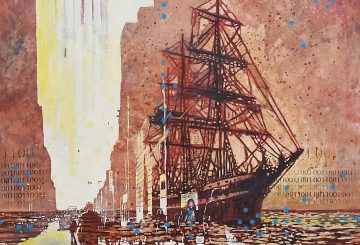Our call for suggestions for influential and important exhibitions brought in some interesting suggestions. The call was in two parts – you could either vote in the poll at the right of the Art Life home page, or, if you disagreed with our selection, you could suggest another or leave a comment under the post below. This seemed to confuse many people, as the poll results show:
Which of the following exhibitions would you rate as the more influential or important in Australian art?
The Field, NGV 1968 16% 27
Christo’s Wrapped Coast, 1969 30% 52
European Dialogue: The 1979 Biennale of Sydney 7% 12
Popism, NGV, 1982 3% 5
Origins, Originality + Beyond: 1984 Biennale of Sydney 7% 12
The Readymade Boomerang: Certain Relations in 20th Century Art 11% 19
Rad Scunge, Karyn Lovegrove Gallery, 1992 5% 9
Another show [nominate in comments] 20% 35
Christo’s Wrapped Coast in Sydney in 1969 was by far the winner of the poll. Another Show meanwhile scored 35 votes but we had a mere 10 comments. Ah, never mind, since we also offered a prize for the most insightful and well reasoned suggestion – a gift of a $17.99 album from iTunes. So who is in the running?
Guest was first in and wrote: “I reckon Signs of Life, Melbourne International Biennale 1999. It was ambitious…to the point where it is the only Melb Biennale to date. It used a derelict Telstra building instead of a white box. It exposed people to a lot of conceptional installation art that was coming out of Europe and the US at the time. It established Julianna Engberg as one of the more adenturous curators of contemporary art. As an art school grad at the time, it felt like a whole new world of art possibiliities had blossomed before me.”
Tony Lloyd also suggested Signs of Life, but had a slightly longer memory, pointing out that it was in fact the second Melbourne Biennale – “the first From the Southern Cross being 11 years before and directed by the late Nick Waterlow. [Signs of Life] was a genuinely thrilling show with stunning works from Ricky Swallow, Maurizio Cattelan, Patricia Piccinini, David Noonan, Mariele Neudecker, Stephen Bush, Cornelia Parker, Callum Morton, Robert Gober, and too many others to recall. The raw concrete and steel of the gutted eight story building that housed the biennale lent it an apocalyptic feel, perfectly apposite to the end of a century; the new art seemingly born from the rubble of the previous hundred years. It showed that art can have power and weight outside the artificial gravity field of the institution, and most importantly it showed that art can be exciting, wonderous, witty and wise. I remember thinking at the time that this show would be the launching point and benchmark for the art of the new century.”
Although The Field attracted a predictably high vote in the poll, a reader suggested an exhibition from the year before, Two Decades of American Art 1967. “Swept away the last of insipid Anglo colonial pseudo-modernism, made New York the place to go,” argues Savant.
Christo’s work in ’69, like Nam June Paik’s visit in the 70s, drew a lot of attention to what was then a marginal artistic practice in Australia. “Conceptual and installation work has dominated Australian art for nearly 40 years,” says Rsrch09. “It was first widely publicised by Christo’s Wrapped Coast but Australian artists working in the style only began to receive wide publicity through a series of exhibitions in the early 1970s with the 1970 Transfield Prize – curated Brian Finemore) – in Sydney, the Szeeman/Kaldor exhibition 1971 in Sydney and Melbourne, Object and Idea – again curated by Brian Finemore) – in Melbourne in 1973 and the Mildura Sculpture Triennials in 1973 and 1975 (curator Tom McCullough). Eveything since has followed in the footsteps of these artists and these exhibitions.”
Daniel Mudie Cunningham had a list of three influential shows: Don’t Leave Me This Way: Art in the Age of AIDS, curated by Ted Gott, National Gallery of Australia, 1994-5, Anita & Beyond, curated by Lisa Havilah, Penrith Regional Gallery & The Lewers Bequest, 2003, and Gallery A Sydney 1964-1983, curated by John Murphy, Campbelltown Arts Centre/Newcastle Region Art Gallery, 2009.
The Asia Pacific Triennial is now in its sixth incarnation, but RK thought that it’s very first outing was notable: “APT 1. Ahead of the curve in so many ways. For all its flaws, it was the first major exhibition to seriously propose a framework for conceiving cultural production in Australia outside the Euro-American canon. In its subsequent iterations it became the country’s most important international exhibition bar none, with a tangible effect on the way in which art in Asia, and to an unfortunately lesser degree, the Pacific, is produced and received. Both a symbol and a model of Brisbane’s transformation from a cultural backwater to a half decent city.”
After much deliberation we’ve decided to award our modest prize to Rscrch09. Sir or madam, please write to us at the art life at hot mail dot com and we’ll sort out the gift giving. Thanks for your help. In the meantime the poll will live a little longer, and we’re still looking for interesting suggestions.

